List of language families
This List of language families also includes language isolates, unclassified languages and other types of languages.
Major language families
By number of languages
Ethnologue 18 lists the following language families as containing at least 1% of the 7,472 known languages in the world:
- Niger–Congo (1,538 languages) (20.6%)
- Austronesian (1,257 languages) (16.8%)
- Trans–New Guinea (480 languages) (6.4%)
- Sino-Tibetan (457 languages) (6.1%)
- Indo-European (444 languages) (5.9%)
- Australian (378 languages) (5.1%)
- Afro-Asiatic (375 languages) (5.0%)
- Nilo-Saharan (205 languages) (2.7%)
- Oto-Manguean (177 languages) (2.4%)
- Austroasiatic (169 languages) (2.3%)
- Volta Congo (108 languages) (1.5%)
- Tai–Kadai (95 languages) (1.3%)
- Dravidian (85 languages) (1.1%)
- Tupian (76 languages) (1.0%)
Glottolog 2.4 lists the following as the largest families:
- Niger–Congo (1,544 languages)
- Austronesian (1,276 languages)
- Indo-European (585 languages)
- Sino-Tibetan (472 languages)
- Atlantic–Congo (432 languages)
- Afro-Asiatic (372 languages)
- Nuclear Trans–New Guinea (315 languages)
- Pama–Nyungan (240 languages)
- Otomanguean (178 languages)
- Austroasiatic (164 languages)
- Tai–Kadai (96 languages)
- Dravidian (81 languages)
- Arawakan (76 languages)
- Mande (74 languages)
- Tupian (71 languages)
Language counts can vary significantly depending on what is considered a dialect. For example, Lyle Campbell counts 27 Otomanguean languages, though he, Ethnologue, and Glottolog disagree as to which languages belong in the family.
Language families
In the following, each bullet item is a known or suspected language family. Phyla with historically wide geographical distributions but comparatively few current-day speakers include Eskimo–Aleut, Na-Dené, Algic, Quechuan and Nilo-Saharan. The geographic headings over them are meant solely as a tool for grouping families into collections more comprehensible than an unstructured list of a few hundred independent families. Geographic relationship is convenient for that purpose, but these headings are not a suggestion of any "super-families" phylogenetically relating the families named. The number of individual languages in a family and number of speakers are only rough estimates. See dialect or language and linguistic demography for further explanation.

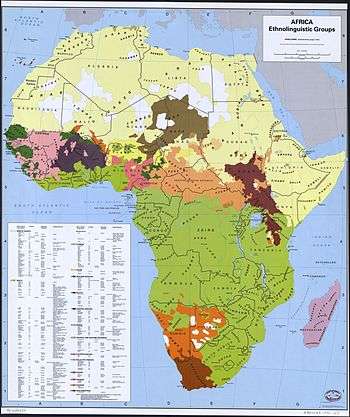
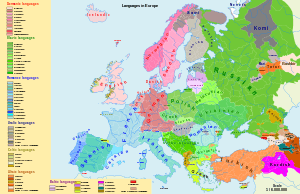

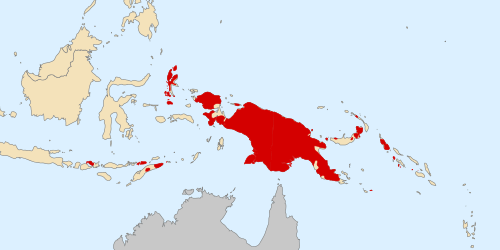
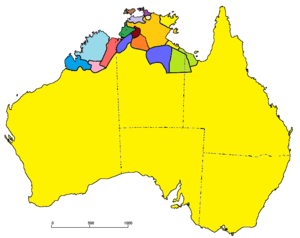
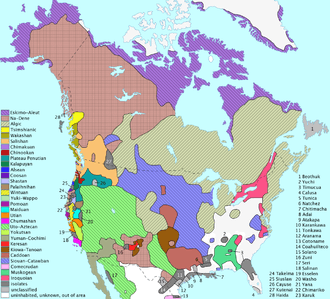

Language isolates
Central & South America
- Aikaná (Brazil: Rondônia)
- Andoque (Colombia, Peru)
- Betoi (Colombia)
- Camsá (Colombia)
- Candoshi-Shapra (Peru)
- Cayubaba (Bolivia)
- Cofán (Colombia, Ecuador)
- Fulniô (Brazil: Pernambuco)
- Guató (Brazil, Bolivia)
- Huaorani (a.k.a. Sabela, Waorani, Waodani) (Ecuador, Peru)
- Irantxe (Brazil: Mato Grosso)
- Itonama (Bolivia)
- Kapixaná (Brazil)
- Koayá (Brazil: Rondônia)
- Leco (Bolivia)
- Mapudungun (Chile, Argentina)
- Movima (Bolivia)
- Omurano (Peru)
- Otí (Brazil: São Paulo) [extinct]
- Páez (Colombia) (see also Paezan)
- Puelche (Argentina, Chile)
- Puquina (Bolivia) [extinct]
- Ticuna (Colombia, Peru, Brazil)
- Warao (Guyana, Surinam, Venezuela)
- Yámana (a.k.a. Yagan) (Chile)
- Yuracare (Bolivia)
- Yuri (Colombia, Brazil)
- Yurumanguí (Colombia)
North America
- Atakapa (US: Louisiana, Texas) [extinct] (part of the hypothetical Gulf languages)
- Chitimacha (US: Louisiana) [extinct] (possibly part of the hypothetical Gulf languages)
- Cuitlatec (Mexico: Guerrero) [extinct]
- Haida (Canada: British Columbia; US: Alaska)
- Huave (Mexico: Oaxaca)
- Karankawa (US: Texas) [extinct]
- Kootenai (Canada: British Columbia; US: Idaho, Montana)
- Natchez (US: Mississippi, Louisiana) (linked to Muskogean in the hypothetical Gulf languages)
- Purépecha (a.k.a. Tarascan) (Mexico: Michoacán)
- Siouan (US: Great Plains, Ohio and Mississippi valleys and southeastern North America)
- Timucua (US: Florida, Georgia) [extinct]
- Tonkawa (US: Texas) [extinct]
- Tunica (US: Mississippi, Louisiana, Arkansas) [extinct] (part of the hypothetical Gulf languages)
- Yuchi (US: Georgia, Oklahoma)
- Zuni (a.k.a. Shiwi) (US: New Mexico)
Australia
- Enindhilyagwa (AKA Andilyaugwa, Anindilyakwa)
- Laragiya
- Minkin [extinct; perhaps a member of Yiwaidjan or Tankic]
- Ngurmbur (perhaps a member of Macro-Pama–Nyungan)
- Tiwi (Melville and Bathurst Islands)
New Guinea
- Abinomn (Baso, Foia) (north Irian)
- Anêm (New Britain)
- Ata (Pele-Ata, Wasi) (New Britain)
- Busa (Sandaun)
- Isirawa (north Irian)
- Kol (New Britain)
- Kuot (Panaras) (New Ireland)
- Massep
- Pyu
- Sulka (New Britain)
- Taiap (Gapun) (Sepik)
- Yalë (Nagatman) (Sandaun)
- Yawa (Geelvink Bay)
- Yélî Dnye (Yele) (Rennell Island)
- Yuri (Karkar) (Sandaun)
Asia
- Ainu language or languages (Japan, Russia) (like Arabic or Japanese, the diversity within Ainu is large enough that some consider it to be perhaps up to a dozen languages while others consider it a single language with high dialectal diversity)
- Nivkh or Gilyak (Russia) (sometimes linked to Chukchi–Kamchatkan)
- Korean (North & South Korea, China, USA, Japan, Russia, Singapore, Thailand) (sometimes linked to Altaic; alternately, Jeju is sometimes classified as a separate language, creating a Koreanic family)
- Kusunda (Nepal)
- Nihali (India) (sometimes linked to Munda)
- Burushaski (Pakistan, India) (sometimes linked to Yeniseian)
- Elamite (Iran) [extinct] (sometimes linked to Dravidian)
- Sumerian (Iraq) [extinct]
- Hattic (Turkey) [extinct] (sometimes linked to Northwest Caucasian)
Africa
Europe
- Basque (Spain, France) (may be related to extinct Aquitanian)
Unclassified languages
Languages are considered unclassified either because, for one reason or another, little effort has been made to compare them with other languages, or, more commonly, because they are too poorly documented to permit reliable classification. Most such languages are extinct and most likely will never be known well enough to classify.
Europe
- Iberian (Spain) (extinct)
- Tartessian (Spain, Portugal) (extinct)
- North Picene (Italy) (extinct)
- Camunic (Italy) (extinct, perhaps Tyrsenian)
- Pictish (Scotland) (extinct, probably Celtic)
- Minoan (Crete) (extinct)
- Eteocretan (Crete) (extinct, probably descended from Minoan)
- Eteocypriot (Cyprus) (extinct)
- Nuragic (Sardinia) (extinct)
- Elymian (Sicily) (extinct)
- Sicani (Sicily) (extinct)
Africa
- Ongota (perhaps Afro-Asiatic)
- Kwadi (extinct; perhaps Khoe)
- Dompo
- Mpre (probably Niger–Congo)
- Jalaa
- Laal
- Meroitic (extinct; probably Nubian, a language family part of the Nilo-Saharan proposal)
- Shabo (perhaps Nilo-Saharan)
- Bayot
- Boro (extinct; perhaps Niger-Congo)
- Kujargé (probably Afro-Asiatic)
- Oblo
- Weyto
- Rimba
Asia
- Quti [extinct]
- Kaskian [extinct] (perhaps related to Hattic)
- Kassite [extinct] (perhaps related to or part of Hurro-Urartian)
- Kenaboi [extinct] (perhaps Mon-Khmer)
- Philistine [extinct] (probably Indo-European)
- Sentinelese (probably Ongan)
- Tambora [extinct] (perhaps related to or a part of the Timor-Alor-Pantar branch of Trans-New Guinea)
New Guinea
- Bayono-Awbono (perhaps Trans-New Guinea)
- Dibiyaso
- Elseng (perhaps Upper Tami)
- Kapori (probably related to Kaure)
- Kehu (probably related to East Geelvink Bay)
- Kembra
- Kimki
- Kosare (probably related to Kaure)
- Purari (perhaps Trans-New Guinea)
- Pyu [moribund] (perhaps Arai-Kwomtari or an isolate)
- Saponi (extinct; perhaps either a Lakes Plain or East Bird's Head – Sentani language)
- Sulka (most likely related to the neighboring Baining and Kol languages)
- Tause (perhaps a part of the East Bird's Head – Sentani proposal)
- Afra [moribund]
South America
- Taushiro (Peru)
Extinct families and unclassified languages
This section lists extinct languages and families which have no known living relatives. While a minority are well-known but are still classified as genetically independent (like the ancient Sumerian language), the lack of attestation makes many languages hard to put into larger groups.
| Name | Languages | Year of death | Location | Well-attested? | Proposed parent family |
|---|---|---|---|---|---|
| Hurro-Urartian languages | 2 | 7th century BC? | Asia | Yes | Alarodian languages |
| Tasmanian languages (several families) | 5-16 | 1905 AD | Australia | Some | |
| Tyrsenian languages | 3 | 3rd century | Europe | Yes | |
| Baenan | 1 | 1940s | South America (Bahia) | No | |
| Culle | 1 | 20th century | South America (North Peru) | No | |
| Kunza | 1 | 1950s? | South America (Atacama) | Some | |
| Gamela | 1 | ? | South America (Maranhão) | No | |
| Gorgotoqui | 1 | 17th century | South America (East Bolivia) | No | |
| Huamoé | 1 | ? | South America (Pernambuco) | No | |
| Malibu languages | 9 | ? | South America (Colombia) | No | |
| Munichi | 1 | 1990s | South America (Loreto) | Some | Arawakan |
| Natú | 1 | 19th century? | South America (Pernambuco) | ||
| Pankararú | 1 | 20th century | South America (East Brazil) | No | |
| Panzaleo | 1 | 17th century | South America (Quito) | No | |
| Sechura | 1 | 19th century? | South America (Piura) | No | |
| Tarairiú | 1 | ? | South America (East Brazil) | No | |
| Tuxá | 1 | 19th century? | South America (East Brazil) | No | |
| Xokó | 1-3 | ? | South America (East Brazil) | No | |
| Xukurú | 1 | ? | South America (East Brazil) | No | Xukuruan |
| Yurumanguí | 1 | 19th century? | South America (Colombia) | No | |
| Adai | 1 | 19th century | North America (Louisiana) | No | |
| Alagüilac | 1 | 18th century? | North America (Guatemala) | No | |
| Aranama-Tamique | 1 | 19th century | North America (Texas) | No | |
| Atakapa | 1 | 20th century | North America (Louisiana) | Some | |
| Beothuk | 1 | 1829 | North America (Newfoundland) | No | |
| Calusa | 1 | 18th century? | North America (Florida) | No | |
| Cayuse | 1 | 1930s | North America (Oregon) | ||
| Cotoname | 1 | 19th century? | North America (Texas-Mexico border) | ||
| Maratino | 1 | ? | North America (Mexico) | No | Uto-Aztecan |
| Naolan | 1 | 1950s | North America (Mexico) | No | |
| Quinigua | 1 | ? | North America (Northeast Mexico) | No | |
| Solano | 1 | 18th century | North America (Texas-Mexico border) | No |
Other language classifications
The classification of languages into families assumes that all languages develop from a single parent proto-language and evolve over time into different daughter language(s). While the vast majority of languages fit this description fairly well, there are exceptions.
A mixed language often refers to a particular combination of existing languages, which may be from different genetic families. A pidgin is a simple language used for communication between groups. This may involve simplification and/or mixing of multiple languages. When a pidgin develops into a more stable language which children learn from birth, it is usually called a creole language.
Whether for ease of use or created for use in fiction, languages can also be constructed from the ground up, rather than develop from existing languages. These are known as constructed languages.
Sign languages
The family relationships of sign languages are not well established due to a lagging in linguistic research, and many are isolates (cf. Wittmann 1991).[3]
| Family Name | Location | Number of Languages |
|---|---|---|
| French Sign | Europe, the Americas, Francophone Africa, parts of Asia | Over 50 |
| British Sign | United Kingdom, Australia, New Zealand, South Africa | 4 - 10 |
| Arab Sign | Much of the Arab World | 6 - 10 |
| Japanese Sign | Japan, Korea, Taiwan | 3 |
| German Sign | Germany, Poland, Israel | 3 |
| Swedish Sign | Sweden, Finland, Portugal | 3 |
Beyond these language families exists many isolate languages, including:
- Inuit Sign Language
- Nicaraguan Sign Language
- Peruvian Sign Language
- Mauritian Sign Language
- Chinese Sign Language
- Hawaiʻi Sign Language
- Lyons Sign Language
Proposed families
A list of proposed language families which connect established families into larger genetic groups. The support for these proposals varies. The Dené–Yeniseian languages, for example, are a recent proposal which has been generally well-received, whereas reconstructions of the Proto-World language are often viewed as fringe science. Proposals which are themselves based on other proposals have the likelihood of their parts noted in parenthesis.
| Proposed name | Description | Mainstream consensus |
|---|---|---|
| Proto-World | reconstructed common ancestor of all living languages | Widely rejected. |
| Amerind | all languages in the Americas which do not belong to the Eskimo–Aleut or Na–Dene families | Widely rejected. |
| Almosan | Algic, Kutenai and Mosan (rejected) | Widely rejected. |
| Mosan | Salishan, Wakashan, and Chimakuan languages of Pacific Northwest North America. | Sprachbund. |
| Aztec–Tanoan | Uto-Aztecan and Tanoan. | Possible. |
| Coahuiltecan | Native languages of modern Texas. | Sprachbund. |
| Gulf | Muskogean with four extinct isolates on US gulf. | Possible. |
| Hokan | A dozen languages on west coast of North America | Some likely, others rejected. |
| Macro-Siouan | Siouan, Iroquoian, Caddoan, and Yuchi. | Controversial. |
| Je–Tupi–Carib | Macro-Jê (likely), Tupian and Cariban of South America. | Possible. |
| Macro-Jê | 11 language families of South America | Some likely, others controversial. |
| Macro-Mayan | Mayan with Totonacan, Mixe–Zoque, and Huave. | Widely rejected. |
| Totozoquean | Totonacan and Mixe–Zoque in Mesoamerica. | Possible. |
| Macro-Panoan | Pano–Takanan (likely) and Mosetén–Chon (likely) | Possible. |
| Macro-Waikurúan | Matacoan, Guaicuruan, Mascoian, and Charruan of South America | ? |
| Penutian | Some languages in western North America | Controversial. |
| Quechumaran | Quechuan and Aymaran | Controversial. |
| Yuki–Wappo | Yuki and Wappo, both extinct. | Likely. |
| Borean | All families except in sub-Saharan Africa, New Guinea, Australia, and the Andaman Islands. | Widely rejected. |
| Alarodian | Northeast Caucasian with extinct Hurro-Urartian | Possible. |
| Sino-Austronesian | Sino-Tibetan, Austronesian, and Tai–Kadai | Controversial. |
| Austric | Austroasiatic, Austronesian and sometimes others. | Some controversial, others rejected. |
| Austro-Tai | Austronesian and Tai–Kadai | Controversial. |
| Miao–Dai | Hmong–Mien and Tai–Kadai | ? |
| Austronesian–Ongan | Ongan and Austronesian | Possible. |
| Dene–Caucasian | Na-Dené, North Caucasian (controversial), Sino-Tibetan, Yeniseian, and others. | Widely rejected. |
| Karasuk | Yeniseian and Burushaski | Possible. |
| Dene–Yeniseian | Na-Dené and Yeniseian | Likely. |
| Nostratic | Many large families in the northern hemisphere. | Widely rejected. |
| Eurasiatic | Many families from Eurasia. | Widely rejected. |
| Indo-Semitic | Indo-European languages and Semitic languages or Afro-Asiatic languages | Widely rejected. |
| Indo-Uralic | Indo-European and Uralic or Uralic–Yukaghir (controversial) | Controversial. |
| Ural–Altaic | Uralic and Altaic (controversial) | Widely rejected. |
| Altaic | Several north Asian families. | Controversial (Sprachbund?) |
| Uralo-Siberian | Uralic, Yukaghir, Eskimo–Aleut and possibly Chukotko-Kamchatkan | Controversial. |
| Uralic–Yukaghir | Uralic and Yukaghir | Controversial. |
| Nivkh–Kamchukotic | Nivkh and Chukotko-Kamchatkan | ? |
| Elamo-Dravidian | Elamite and Dravidian | ? |
| Pontic | Northwest Caucasian and Indo-European | Controversial. |
| Ibero-Caucasian | Northwest Caucasian, Northeast Caucasian, and Kartvelian | Controversial. |
| North Caucasian | Northwest Caucasian and Northeast Caucasian | Controversial. |
| Indo-Pacific | Several Pacific families. | Widely rejected. |
| Macro-Pama–Nyungan | Several Australian language families. | Controversial. |
| Kongo–Saharan | Niger–Congo and Nilo-Saharan | Controversial. |
| Nilo-Saharan | Many families of central Africa. | Controversial. |
| Macro-Khoisan | African click-consonant languages that do not belong to any other macrophyla. | Widely rejected. |
| Na-Dene (with Haida) | Sapir's proposal. | Controversial. |
See also
- International auxiliary language
- Constructed language
- Endangered language
- Extinct language
- Intercontinental Dictionary Series
- Ethnologue#Language families
- Glottolog#Language families
- Language_isolate#List_of_language_isolates_by_continent
References
- ↑ http://www.ethnologue.com/subgroups/north-caucasian-1
- ↑ http://www.ethnologue.com/subgroups/north-caucasian-1
- ↑ Wittmann, Henri (1991). "Classification linguistique des langues signées non vocalement." Revue québécoise de linguistique théorique et appliquée 10:1.215-88.PDF
External links
- Glottolog
- Ethnologue
- MultiTree Project
- Comparative Swadesh list tables of various language families (from Wiktionary)